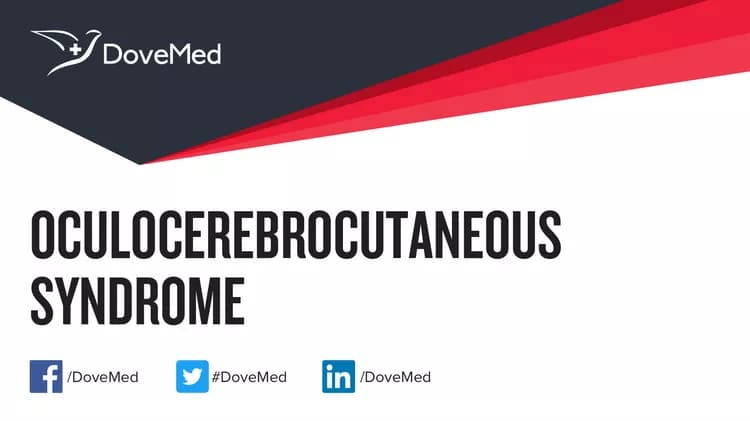What are the other Names for this Condition? (Also known as/Synonyms)
- Delleman Syndrome
- OCC Syndrome
- Orbital Cyst with Cerebral and Focal Dermal Malformations
What is Oculocerebrocutaneous Syndrome? (Definition/Background Information)
- Oculocerebrocutaneous Syndrome (OCCS) is an uncommon genetic disorder predominantly seen in males that is characterized by the presence of lesions in the eye, brain, and skin. In many individuals, the condition is severe due to brain malformations, apart from spinal cord abnormalities
- The cause of development of Oculocerebrocutaneous Syndrome is presently not well-understood. A positive family history of OCCS has also not been reported. The disorder may develop due to genetic abnormalities involving the X chromosome, since its mostly seen in males
- A treatment of Oculocerebrocutaneous Syndrome involves addressing the signs and symptoms and includes medications, use of hearing/vision aids, surgery, and physical and occupational therapy. The prognosis of OCCS may be highly variable and depends on the severity of the condition
Who gets Oculocerebrocutaneous Syndrome? (Age and Sex Distribution)
- Oculocerebrocutaneous Syndrome is an extremely rare congenital disorder with fewer than 50 cases reported in the medical records
- The presentation of symptoms may occur at or following the birth of the child
- Both males and females may be affected, although a vast majority of cases are seen in males
- Individuals of all racial and ethnic groups may be affected
What are the Risk Factors for Oculocerebrocutaneous Syndrome? (Predisposing Factors)
- Currently, no risk factors have been clearly identified for Oculocerebrocutaneous Syndrome
- Among the recorded cases in medical literature, a positive family history has not been observed
It is important to note that having a risk factor does not mean that one will get the condition. A risk factor increases one’s chances of getting a condition compared to an individual without the risk factors. Some risk factors are more important than others.
Also, not having a risk factor does not mean that an individual will not get the condition. It is always important to discuss the effect of risk factors with your healthcare provider.
What are the Causes of Oculocerebrocutaneous Syndrome? (Etiology)
- The exact cause of Oculocerebrocutaneous Syndrome is presently unknown
- It is reported that the disorder may develop from genetic factors involving the X chromosome, since males are affected the most
What are the Signs and Symptoms of Oculocerebrocutaneous Syndrome?
The signs and symptoms of Oculocerebrocutaneous Syndrome may vary significantly from one individual to another depending on the location of the lesions in the brain. The condition may be mild or severe, and may include the following signs and symptoms:
- Underdeveloped or absent skin
- Craniofacial anomalies (abnormal facial features) including:
- Asymmetrical face; skull defect
- Facial cleft
- Malformed external ears
- Skin tag near the ear (preauricular skin tag)
- Droopy eyelid
- Wide mouth
- Presence of orbital cysts
- Iris coloboma
- Corpus callosum (brain hemisphere) abnormalities
- Hearing impairment
- Loss of hair (alopecia)
- Rib and vertebral anomalies
- Hand and feet abnormalities such as finger syndactyly, hand polydactyly, and talipes
- Seizures may be noted in 50% of the individuals
- In some individuals, only one side of the body is affected (typically, the left side is involved more than the right side)
- Partial paralysis
- Mild growth delays and cognitive impairment
How is Oculocerebrocutaneous Syndrome Diagnosed?
Oculocerebrocutaneous Syndrome may be diagnosed on the basis of the following information:
- Physical examination of the individual and medical history evaluation
- Neurological evaluation, including electroencephalography (EEG)
- Eye and vision exams
- Dermoscopy: Dermoscopy is a diagnostic tool where a dermatologist examines the skin using a special magnified lens
- Wood’s lamp examination: In this procedure, the healthcare provider examines the skin using ultraviolet light. It is performed to examine the change in skin pigmentation
- Radiological studies of the affected regions, including CT/MRI scans
- Skin biopsy, if necessary: A skin biopsy is performed and sent to a laboratory for a pathological examination. The pathologist examines the biopsy under a microscope. After putting together clinical findings, special studies on tissues (if needed) and with microscope findings, the pathologist arrives at a definitive diagnosis
- Diagnostic tests to check for an underlying disorder or condition if present
A differential diagnosis may be necessary to eliminate other conditions that present similar signs and symptoms. This may include:
- Aicardi syndrome
- Encephalocraniocutaneous lipomatosis (ECCL)
- Focal dermal hypoplasia
- Oculo-auriculo-vertebral spectrum (OAVS)
Many clinical conditions may have similar signs and symptoms. Your healthcare provider may perform additional tests to rule out other clinical conditions to arrive at a definitive diagnosis.
What are the Possible Complications of Oculocerebrocutaneous Syndrome?
The complications of Oculocerebrocutaneous Syndrome may vary from one individual to another, and may include:
- Congenital diaphragmatic hernia
- Congenital hip dislocation
- Severe hearing and vision loss
- Physical growth and development delays
- Orbital encephalocele
- Agenesis of corpus callosum
- Cerebellar hypoplasia
- Impairment of brain function including intellectual disability
- Severely decreased quality of life
Complications may occur with or without treatment, and in some cases, due to treatment also.
How is Oculocerebrocutaneous Syndrome Treated?
Presently, there is no cure for Oculocerebrocutaneous Syndrome. The treatment is mainly given to manage the signs and symptoms and any complications that develops. A multidisciplinary team of specialists and healthcare professionals are involved in managing the condition.
The management measures may include:
- Antiseizure medication for seizures
- Surgical drainage and/or removal of orbital cysts
- Use of visual and hearing aids
- Nutritional support and growth hormone therapy
- Surgical repair of defects, as needed
- Physical therapy, occupational therapy, and supportive care
- Psychotherapy and behavior modification
Regular medical screening at periodic intervals with tests and physical examinations are recommended.
How can Oculocerebrocutaneous Syndrome be Prevented?
Currently, Oculocerebrocutaneous Syndrome may not be preventable since it is a genetic disorder.
- Genetic testing of the expecting parents (and related family members) and prenatal diagnosis (molecular testing of the fetus during pregnancy) may help in understanding the risks better during pregnancy
- If there is a family history of the condition, then genetic counseling will help assess risks, before planning for a child
- Active research is currently being performed to explore the possibilities for treatment and prevention of inherited and acquired genetic disorders
What is the Prognosis of Oculocerebrocutaneous Syndrome? (Outcomes/ Resolutions)
- The prognosis of Oculocerebrocutaneous Syndrome is dependent upon the severity of the signs and symptoms and associated complications, if any
- In many individuals, since the brain is typically involved, the overall functionality involving both physical and mental growth is often severely affected
Additional and Relevant Useful Information for Oculocerebrocutaneous Syndrome:
The following DoveMed website link is a useful resource for additional information:
Related Articles
Test Your Knowledge
Asked by users
Related Centers
Related Specialties
Related Physicians
Related Procedures
Related Resources
Join DoveHubs
and connect with fellow professionals



0 Comments
Please log in to post a comment.